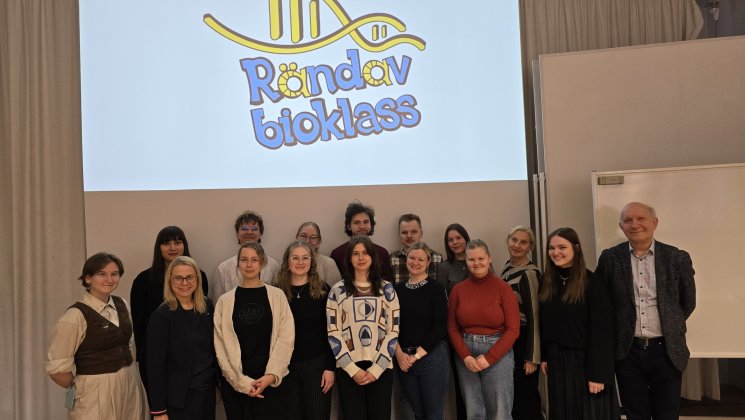New research grants in IMCB

At the beginning of 2022, five new research projects started in the IMCB. The principal investigators of these projects are Priit Väljamäe, Angela Ivask, Rita Hõrak, Indrek Teino (on the photo from left to right) and Mariliis Klaas.
Here we present all five new projects and their principal investigators (PI-s):
Priit Väljamäe, co-professor of general and microbial biochemistry at the University of Tartu, who recently received a national research award, focuses on the enzymatic degradation of recalcitrant polysaccharides, cellulose and chitin, in the project "Lytic polysaccharide monooxygenases in degradation of recalcitrant polysaccharides"
The team's research has focused on recently discovered and high-potential enzymes, lytic polysaccharide monooxygenases (LPMOs). Since hydrogen peroxide, the cosubstrate of LPMOs, is a so-called double-edged sword, which is essential for the operation of LPMOs, but also lethal, in addition to the degradation of repulsive polysaccharides, they investigate the molecular mechanisms behind the inactivation (death) of LPMOs.
As a result of the project, it is hoped to find out the mechanism of operation of the "LPMO Life Day Clock" and to find ways to extend the life of LPMOs. By controlling the stability of LPMOs, researchers hope to develop a mixture of enzymes for the efficient degradation of recalcitran polysaccharides.
Angela Ivask, Professor of Genetics at the University of Tartu, wants to find out in her project "Bacterial Stress Responses and Physiological Adaptation on Antimicrobial Surfaces and Their Role in the Development of Antibiotic Resistance".
The issue is currently topical, as the amount of antimicrobials - disinfectants, surface treatments, etc. - is growing, but it is also known that the bacteria that survive antimicrobial treatment experience significant stress. This project seeks to understand exactly what stress is caused by such bacterial cells and what the consequences may be for the bacterial population. The project investigates the transfer of genetic material between bacteria, the increase in mutations and the change in bacterial life forms under the stress conditions of the most commonly used antimicrobials in the products on the market and some of their own. The results are important to understand the longer-term effects of antimicrobials and to identify those that would have the least adverse effects, such as the spread or development of resistance.
By the end of the project, it is hoped to provide an overview of the bacterial stress responses following antimicrobial treatment and to provide antimicrobial solutions with the least long-term effects. "The best antimicrobial treatment is one that destroys as many microbes as possible as quickly as possible and does not cause significant physiological changes in the surviving microbes associated with stress responses," says Professor Ivask.
Rita Hõrak, co-professor of genetics at the University of Tartu, studies in her project, "Chromosomal Toxin-Antitoxin Systems – a Mechanism to Resist Phage Infection?", how the bacterium protects itself against viral or phage infection. More specifically, it is desired to elucidate whether and how prophages and potentially lethal toxin-antitoxin gene pairs found in bacterial genomes are involved in phage protection..
By the end of the project, the research group plans to achieve the following results:
- to create a collection of bacteriophages (containing at least 50-100 phages) isolated from environmental samples that can infect the model organism they use - the soil bacterium Pseudomonas putida;
- to elucidate the role of four prophets in the P. putida genome in phage protection;
- to determine whether P. putida chromosomal toxin-antitoxin loci are involved in phage protection;
- to study the effect of toxin-antitoxin systems on prophylaxis on prophylaxis.
Mariliis Klaas, a researcher in cell biology at IMCB, is the PI for her new project Interactions between the extracellular matrix and macrophages in the pathology of Dupuytren's disease. Dupuytren's disease is a widespread chronic fibrous disease of the palm that lacks modern treatments.
The knowledge gained from this research project will allow the discovery of new drug targets that can be used to develop therapies for Dupuytren's disease as well as other fibrotic diseases.
The mechanism of the disease has not been precisely described, but the hypothesis of Marilis Klaas' work is that the interactions between the extracellular matrix and macrophages play an important role in the phenotypic differentiation of macrophages and the development of fibrotic disease. The aim of the project is to characterize the changes in the extracellular matrix of Dupuytren's tissue and to study which molecules and how the accumulated macrophages influence the development of inflammation.
Indrek Teino, a recent postdoctoral researcher at the University of Helsinki and a researcher in cell biology at IMCB, is the principal investigator of his new project "Methylation of mRNA at Adenosine N6 Supports Dopamine Neuron Survival – New Small-Molecule Compounds for Parkinson’s Disease Therapy."
This project elucidates the role of mRNA methylation in Parkinson's disease. In particular, Teino investigates how different low molecular weight mRNA methylation compounds may support the survival of dopamine neurons in different animal models of Parkinson's disease. The same compounds will be potential drugs for humans in the future.
Teino believes, that by the end of the project his research team is at a stage where new compounds have been found for further drug development and their mechanisms of action have been described.
Annotations of all the above projects from the Estonian Research Information System (ETIS):
"Personal research funding: Start-up grant (PSG)" project PSG737 (ETIS)
Fibrotic diseases can affect almost every organ and represent a major unmet medical need worldwide. Dupuytren’s disease (DD) is a chronic fibrotic disease of the hand which leads to permanent flexion deformities. The cause of DD is not known and currently there are no approved treatment to control the progression of early-stage DD. The aim of this project is to discover novel drug targets for treatment of DD using high throughput omics approach coupled to functional assays in tissue culture. We will characterize the molecular interactions between immune cells macrophages and the components of the extracellular matrix which are important for progression of fibrosis. Knowledge obtained from this project can help in medicine to develop therapies for DD.
"Personal research funding: Team grant (PRG)" project PRG1496 (ETIS)
Here we study the stress responses and physiological adaptation of bacteria after their exposure to antimicrobial materials, and the role of the observed adaptations in the development of antibiotic resistance. It is known that unfavourable environment, including antimicrobials, induce various stress response pathways in bacterial cells. The outcomes may be physiological changes that lead to a higher resistance towards the specific unfavourable environment but may also increase bacterial tolerance or resistance towards other stressors, e.g., antibiotics. We will utilise five different types of antimicrobial materials with different modes of action and effect speeds to follow their induced stress responses, physiological and genetic changes in bacteria. By linking the observed stress response pathways with bacterial antibiotic sensitivity profiles we will draw conclusions on the potential of antimicrobial products to induce antibiotic tolerance and resistance in real-life situations.
"Personal Post-doctoral Research Funding (PUTJD)" project PUTJD1101 (ETIS)
Parkinson’s disease (PD) is a neurodegenerative disease characterised by degeneration and death of midbrain dopamine (DA) neurons. As current treatments only alleviate symptoms, novel and more efficient therapeutic options are needed. Although the aetiology of PD is unclear, recent evidence point to disturbances in mRNA methylation at adenosine N6 (m6A). Prof. Mart Saarma and collaborators have developed and tested unique compounds that enhance m6A levels in cell mRNAs. Preliminary results show that these compounds protect DA neurons from neurotoxin-induced death in culture, remarkably improve motor behaviour and protect DA neurons in rat model of PD. Considering this, the aim of the current project is to identify for the first time the mRNAs with increased methylation at adenosine N6 contributing to DA neuron survival in vitro and in vivo. In addition, we will determine the underlying mechanisms, provide lead molecules and determine their properties for further drug development.
"Personal research funding: Team grant (PRG)" project PRG1431 (ETIS)
Toxin-antitoxin systems (TAS) are widespread in bacterial chromosomes. TAS are often claimed to be associated with regulation of host stress tolerance, persistence or biofilm formation, yet, recent results have rebutted TAS role in these phenotypes. Moreover, our recent data show that rather than being beneficial, chromosomal TAS are costly for the host. Why then the plethora of TAS loci are maintained in bacterial chromosomes? The goal of this project is to examine whether chromosomal TAS are implicated in a host-phage arms race. We will test whether TAS can protect bacteria against invading phages and stabilize the lysogenic prophages in the host genome. We expect to find out whether the selfish characters of TAS can be traded off against their benefit under conditions of phage attack. The knowledge gained will make an important contribution to the ongoing debate on the biological function of TAS and will also improve our understanding of mechanisms employed in host-phage arms race.
"Personal research funding: Team grant (PRG)" project PRG1540 (ETIS)
Structural polysaccharides cellulose and chitin represent a huge reservoir of renewable carbon. Their enzymes-aided valorization provides a green and sustainable alternative to the traditional, petroleum-based industry. Crystalline structure makes cellulose and chitin recalcitrant towards enzymatic degradation. Their efficient degradation can be achieved only by cooperation of different enzymes. Rational design of optimal enzyme mixtures implies in-depth understanding of the mechanisms of individual components. Recently discovered lytic polysaccharide monooxygenases (LPMOs) have secured their place in the state of art commercial enzyme mixtures. However, insufficient knowledge about the stability and mechanism of LPMOs has hampered the harnessing of their full potential. The present project aims to fill this gap by generating in-depth understanding about the mechanism of LPMOs action and their interplay with other enzymes involved in degradation of recalcitrant polysaccharides.
Photo: Andres Tennus / University of Tartu






